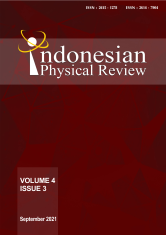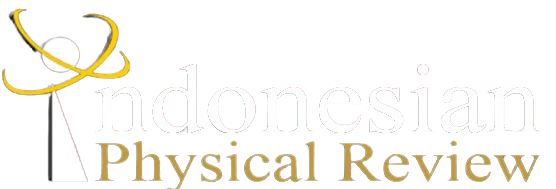Abstract
Indonesia is a country with high earthquake potential. This potential has been realized by its stakeholders and other parties. Various methods from many researchers from the fields of geophysics, geology, seismology, geodesy, geotechnical engineering, and others have been discussed to arrange earthquake mitigation. However, the discussions are unable to fit all earthquake mitigations across the country because they are still limited to specific characteristics of each fault among thousands of faults in Indonesia. Seismic moment is a parameter that provides information on the energy released when an earthquake occurs. This parameter, in any given scale, can provide information about the earthquake recurrence interval. The earthquake recurrence interval referred to here means that during a certain time period, the area under study has the possibility of experiencing an identical earthquake or with a smaller magnitude. This study tries to offer and test the method of calculating earthquake recurrence interval based on seismic moments. The method tested in several case studies of earthquakes in East Kalimantan has acceptable results. The method in this research has advantages value and can be alternative method in earthquake disaster mitigation.Keywords:
Earthquake recurrence interval, Magnitude, Seismic momentReferences
E. P. Umar, H. Bakri, and M. Karnaen, “Mekanisme Sumber Gempabumi (Focal Mechanism) Manokwari,†J. Geomine, vol. 04, no. 1, pp. 11–18, 2016, doi: 100.33536/jg.v4i1.38.
A. Abu Bakar, D. Mardiatno, and M. A. Marfai, “Study on potential tsunami by earthquake in subduction zone of Sulawesi Sea,†Arab. J. Geosci., vol. 10, no. 24, p. 553, 2017, doi: 10.1007/s12517-017-3286-4.
M. A. Massinai and M. F. I. Massinai, “Determination Hypocentre and Focal Mechanism Earthquake of Oct 31, 2016 in Bone, South Sulawesi,†J. Phys. Conf. Ser., vol. 979, no. 012045, pp. 1–5, 2018, doi: 10.1088/1742-6596/979/1/012045.
M. F. I. Massinai, A. P. Astuti, M. R. B. Kiraman, M. A. Massinai, and M. Ramdhan, “Hypocenter Determination and Focal Mechanism Solution of May 29 2017 Earthquake around Poso, Central Sulawesi, Indonesia,†J. Phys. Conf. Ser., vol. 1341, no. 082017, pp. 1–5, 2019, doi: 10.1088/1742-6596/1341/8/082017.
R. M. Taruna, V. H. Banyunegoro, and G. Daniarsyad, “Peak ground acceleration at surface for Mataram city with a return period of 2500 years using probabilistic method,†in MATEC Web of Conferences, 2018, vol. 195, doi: 10.1051/matecconf/201819503019.
J. Ren and S. Zhang, “Estimation of recurrence interval of large earthquakes on the central longmen shan fault zone based on seismic moment accumulation/release model,†Sci. World J., no. 458341, pp. 1–8, 2013, doi: 10.1155/2013/458341.
E. Marekova, “Analysis of the spatial distribution between successive earthquakes occurred in various regions in the world,†Acta Geophys., vol. 62, no. 6, pp. 1262–1282, 2014, doi: 10.2478/s11600-014-0234-5.
A. Deif and I. El-Hussain, “Seismic moment rate and earthquake mean recurrence interval in the major tectonic boundaries around Oman,†J. Geophys. Eng., vol. 9, no. 6, pp. 773–783, 2012, doi: 10.1088/1742-2132/9/6/773.
Y. Ji and S. Yoshioka, “Depth variation of seismic moment and recurrence interval in Japan,†Geosci. Lett., vol. 8, no. 1, pp. 1–16, 2021, doi: 10.1186/s40562-020-00173-5.
E. M. Scordilis, “Empirical global relations converting MS and mb to moment magnitude,†J. Seismol., vol. 10, pp. 225–236, 2006, doi: 10.1007/s10950-006-9012-4.
R. Das, M. L. Sharma, H. R. Wason, D. Choudhury, and G. Gonzalez, “A Seismic Moment Magnitude Scale,†Bull. Seismol. Soc. Am., vol. 109, no. 4, pp. 1542–1555, Jul. 2019, doi: 10.1785/0120180338.
R. Joshi, S. S. Bhadauria, and S. S. Kushwaha, “Probabilistic seismic hazard analysis of Madhya Pradesh (Central India) using alternate source models: a logic tree approach,†Asian J. Civ. Eng., vol. 21, no. 8, pp. 1399–1414, 2020, doi: 10.1007/s42107-020-00286-4.
D. Di Giacomo, I. Bondár, D. A. Storchak, E. R. Engdahl, P. Bormann, and J. Harris, “ISC-GEM : Global Instrumental Earthquake Catalogue ( 1900 – 2009 ), III . Re-computed M S and m b , proxy M W , final magnitude composition and completeness assessment,†Phys. Earth Planet. Inter., vol. 239, pp. 33–47, 2015, doi: 10.1016/j.pepi.2014.06.005.
M. Ramdhan, “Analisis Kegempaan Sesar Sumatera Menggunakan Relokasi Gempabumi Metoda Double-Difference,†ITB, 2012.
M. Irsyam et al., Peta Sumber dan Bahaya Gempa Indonesia Tahun 2017, First Ed. Bandung, Indonesia: Pusat Penelitian dan Pengembangan Perumahan dan Pemukiman, Kementerian Pekerjaan Umum dan Perumahan Rakyat Republik Indonesia, 2017.
E. Purnamasari, “The Influence of RSNI 1726: 2018 Based on The 2017 Indonesia Earthquake Map of Seismic Earthquake Load Design in South Kalimantan,†J. Teknol. Berkelanjutan, vol. 7, no. 2, pp. 73–81, 2018, doi: 10.20527/jtb.v7i02.91.
P. Wessel, W. H. F. Smith, R. Scharroo, J. Luis, and F. Wobbe, “Generic Mapping Tools: Improved Version Released,†Eos Trans. Am. Geophys. Union, vol. 94, no. 45, pp. 409–410, 2013, doi: 10.1002/2013EO450001.
S. Pailoplee, “Probabilities of Earthquake Occurrences along the Sumatra-Andaman Subduction Zone,†Open Geosci., vol. 9, pp. 53–60, 2017, doi: 10.1515/geo-2017-0004.
R. Fidia, D. Pujiastuti, and A. Z. Sabarani, “Korelasi Tingkat Seismisitas dan Periode Ulang Gempa Bumi di Kepulauan Mentawai dengan Menggunakan Metode Guttenberg- Richter,†J. Fis. Unand, vol. 7, no. 1, pp. 84–89, 2018, doi: 10.25077/jfu.7.1.84-89.2018.
C. Li, W. Zheng, and W. Wang, “Trenching exposures of the surface rupture of 2008 Mw 7.9 Wenchuan earthquake, China: Implications for coseismic deformation and paleoseismology along the Central Longmen Shan thrust fault,†J. Asian Earth Sci., vol. 40, no. 4, pp. 825–843, 2011, doi: 10.1016/j.jseaes.2010.04.011.
Y. K. Ran et al., “Paleoseismic events and recurrence interval along the Beichuan-Yingxiu fault of Longmen shan fault zone, Yingxiu, Sichuan, China,†Tectonophysics, vol. 584, pp. 81–90, 2013, doi: 10.1016/j.tecto.2012.07.013.
A. Posadas, J. Morales, J. M. Ibañez, and A. Posadas-Garzon, “Shaking earth: Non-linear seismic processes and the second law of thermodynamics: A case study from Canterbury (New Zealand) earthquakes,†Chaos, Solitons and Fractals, vol. 151, no. 111243, pp. 1–12, 2021, doi: 10.1016/j.chaos.2021.111243.
N. Ahmed, “Recurrence of Space-Time Events,†J. Mod. Phys., vol. 06, no. 13, pp. 1793–1797, 2015, doi: 10.4236/jmp.2015.613182.
A. J. Rodgers, A. Pitarka, N. A. Petersson, B. Sjögreen, and D. B. McCallen, “Broadband (0–4 Hz) Ground Motions for a Magnitude 7.0 Hayward Fault Earthquake With Three-Dimensional Structure and Topography,†Geophys. Res. Lett., vol. 45, no. 2, pp. 739–747, 2018, doi: 10.1002/2017GL076505.
T. Omi, I. Kanter, and S. Shinomoto, “Optimal observation time window for forecasting the next earthquake,†Phys. Rev. E - Stat. Nonlinear, Soft Matter Phys., vol. 83, no. 026101, pp. 1–5, 2011, doi: 10.1103/PhysRevE.83.026101.
License
Authors who publish with Indonesian Physical Review Journal, agree to the following terms:
- Authors retain copyright and grant the journal right of first publication with the work simultaneously licensed under a Creative Commons Attribution-ShareAlike 4.0 International Licence (CC BY SA-4.0). This license allows authors to use all articles, data sets, graphics, and appendices in data mining applications, search engines, web sites, blogs, and other platforms by providing an appropriate reference. The journal allows the author(s) to hold the copyright without restrictions and will retain publishing rights without restrictions.
- Authors are able to enter into separate, additional contractual arrangements for the non-exclusive distribution of the journal's published version of the work (e.g., post it to an institutional repository or publish it in a book), with an acknowledgment of its initial publication in Indonesian Physical Review Journal.
- Authors are permitted and encouraged to post their work online (e.g., in institutional repositories or on their website) prior to and during the submission process, as it can lead to productive exchanges, as well as earlier and greater citation of published work (See The Effect of Open Access).





